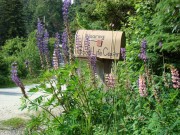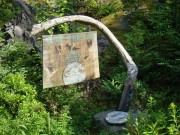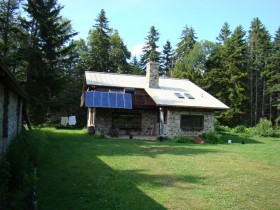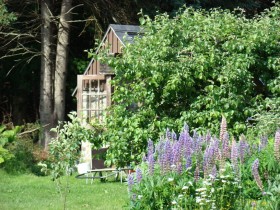 (1904-1995) was a self-sufficient organic farmer and author whose life with her husband, Scott Nearing, struck a powerful chord with thousands of people. Later labeled the “back-to-the-land movement,” generations of people, some disenfranchised by McCarthyism, the Vietnam War, and the greed of modern society, adopted new values exemplified by the Nearings and others. These included values such as life in harmony with nature, simplicity, organic farming, and houses unconnected to power grids.
(1904-1995) was a self-sufficient organic farmer and author whose life with her husband, Scott Nearing, struck a powerful chord with thousands of people. Later labeled the “back-to-the-land movement,” generations of people, some disenfranchised by McCarthyism, the Vietnam War, and the greed of modern society, adopted new values exemplified by the Nearings and others. These included values such as life in harmony with nature, simplicity, organic farming, and houses unconnected to power grids.
Helen Knothe was born in 1904 in New Jersey. Her family provided a stable, intellectually stimulating, Theosophical* home. Helen grew up eating vegetarian food, a trait that would bring her and Scott together. She studied the violin vigorously, and was an accomplished musician. Her lifelong plan to continue the violin through college was interrupted by her encounter and subsequent relationship with an emerging cultural and religious leader, an Indian man named Jiddu Krishnamurti. Helen spent several years in contact with him before they went their separate ways. Even in the midst of young love, Helen maintained an individual life, and played the violin, though she had decided that music would not be her life’s focus.
In 1928, Helen and Scott began a relationship that would last for 55 years. Scott was 45, divorced from his wife, the mother of his two children. His career as a professor had recently ended when his views were deemed too far left for an American or Canadian school of higher learning. Helen and Scott found in each other a partner who encouraged individualism while providing love and support. Scott was very analytical; Helen was very sentimental. Their differences were rarely problematic: Scott appreciated Helen’s sense of aesthetics; Helen appreciated Scott’s clear and focused thinking, as well as his undivided commitment to making the world a better place.
After a few years of poverty in New York City, Scott and Helen moved to Pike Valley, outside of Jamaica, Vermont, in 1932 where they set up a maple sugar business and practiced organic farming. At the close of the Korean War, Vermont experienced a booming real estate business that coincided with the start of ski business on Stratton Mountain near them. The increasingly materialistic culture of southern Vermont did not mesh with Nearings’ vision of the future. In 1952, they sold their land and moved to Harborside in Brooksville, on Cape Rosier. Their decision was a natural one; after years in the mountains, they wanted to start again by the ocean.
Their home on the Maine coast became a compound of stone buildings and walls, all built by hand. The success of their book Living the Good Life (1954), republished in 1970, inspired many followers who came to Maine to see the Nearings’ self-sufficient life in action. Their home became a destination for people wanting to learn organic farming, how to live in harmony with nature, and learn the benefits of healthy living. Over the years thousands of people showed up at the doorstep. While Scott was sometimes away on speaking tours, Helen was usually found at home, ready to welcome and feed her many guests and friends. At the age of 100 in 1983, Scott died at their farm, “a conscious , controlled, at-home death” (Sarris, p. 465). Helen kept the farm going with the help of friends and disciples. She died in an automobile accident in 1995.
After Helen Nearing’s death, the farm was converted into the Good Life Center. It is still a working farm, and it still welcomes individuals and groups who want to see how to live self-sufficiently. Everyone who visits is encouraged to help in some way, though sometimes when Helen was still alive there were so many visitors that it was difficult for her to find work for all of them.
*”teaching about God and the world based on mystical insight” – Merriam Webster’s Collegiate Dictionary, 10th Edition.
Additional resources
Bright, Jean Hay. Meanwhile, Next Door to the Good Life. Dixmont, Me. BrightBerry Press. 2003.
Jackson, W. Charles. Quest for the Good Life: Helen and Scott Nearing and the Ecological Imperative. Orono, Me. 1993. (Thesis (M.A.) in History–University of Maine, 1993) [University of Maine, Raymond H. Fogler Library, Special Collections]
Killinger, Margaret O. Helen Knothe Hearing: A Biography. Thesis (Ph.D.) in History–University of Maine 2004.
Killinger, Margaret O. The Good Life of Helen K. Nearing. Burlington, Vt. University of Vermont Press; Hanover. University Press of New England. c2007.
Nearing, Helen. Loving and Leaving the Good Life. White River Junction, VT: Chelsea Green. 1992.
Nearing, Helen and Scott. Living the Good Life. New York: Schocken, 1954, 1970.
Nearing Helen and Scott. Continuing the Good Life. New York: Harper Row, 1979.
Nearing Helen and Scott. The Maple Sugar Book. White River Junction, VT. Chelsea Green Publishing. 2000. (original publication 1950)
Sarris, Andres. “Helen Knothe Nearing” in Notable American Women, A Biographical Dictionary: Completing the Twentieth Century. Cambridge, Harvard University Press, 2004.
“The Goodlife Center at Forest Farm, Harborside.”http://www.goodlife.org/ (accessed May 29, 208)
Contributed by Karen L. Sherlock, Edgecomb, Maine, 2008.





